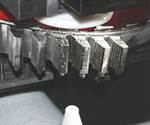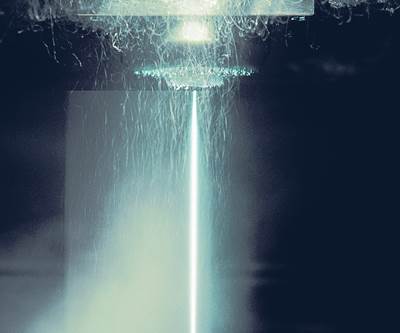Buying a Wire EDM, Part 2: Wire Considerations
Each type of EDM wire has its strengths and weaknesses. This post reviews wire types, the importance of tensile strength and wire rethreading.
This is part two of a four-part series about buying a wire EDM. For more on Wire EDM, click the links:
- Part One: How It Works
- Part Three: Speed, Accuracy and Finish
- Part Four: Dielectric Fluid & Maintenance
Find more insights about acquiring a new machine tool by visiting the Techspex Knowledge Center.
The wire used in the electrical discharge machining (EDM) process may consist of brass, zinc-coated brass, brass-coated copper, tungsten, molybdenum or brass with a steel core, to name a few. Each type has its own purpose, benefit and cost.
Types and Sizes of EDM Wire
EDM wire ranges in diameter from 0.0008 to 0.013 inch. A wire with a diameter of 0.0008 inch will produce a 0.00044-inch radius in a corner, a feature nearly impossible to manufacture any other way. Such precision may be required for openings in dies to produce electrical components, for example. However, wire this fine is rarely used, because of the unusual challenges it creates. Typically, the smaller the wire, the lower the power settings and the slower the cut. Most shops do not want to pay for this lengthy machine time unless the application absolutely requires it.
Plain brass wire 0.010 inches in diameter is used in more than 80 percent of EDM work. Three types of brass wire exist: hard, half-hard and soft. Soft brass is typically used for cutting tapers because a low tensile strength is needed. This type can bend while cutting at an angle without breaking.
Hard brass is best for both roughing and skimming when higher tensile strength is desired. Hard brass withstands aggressive flushing and enables a high voltage to be applied to the wire without breaking. A faster cutting rate is the result.
Brass wire is available with a zinc coating. Because zinc melts at a lower temperature than brass, the zinc absorbs heat as it boils away. Less heat enters the wire, so it retains its strength. Whereas brass wire is very smooth on the outside, zinc-coated brass has a rougher outside finish. This rougher finish improves flushing, resulting in increased speed. Typically, coated wire delivers a 10- to 15-percent improvement in speed.
Wire with a copper core and a defused zinc outer layer is often referred to as a high-speed wire, or stratified wire. The high electrical conductivity of copper enables doubling the cut speed. However, the price of the wire can be double that of other types. A stratified wire is recommended for roughing cuts. Plain copper wire is now rarely used because it is too soft and is too expensive.
No matter which type of wire is selected, it can only be used once. All wire is degraded by the wire EDM process and can be sold for scrap afterward.
Wire Tensile Strength
Specifying the tensile strength of EDM wire is also important. Even though the wire does not touch the part during cutting, it is stretched by the machine’s wire drive feed mechanism, which consists of wire tensioner, roller guides, and upper and lower feed contacts (where the electric current is applied). Tension is preloaded onto the wire and can then be increased or decreased to accomplish different cutting techniques. Tensile strength determines the ability of the wire to withstand the tension imposed during cutting. The lower the tensile strength, the easier it is to break.
Wire with less tensile strength will cut angles without breaking. By displacing or offsetting the wire guides in the U-V axis, large tapers and angle cuts of up to 45 degrees can be generated. Wire with more tensile strength can be stretched more tightly when using the U-V axis to closely control the perpendicularity of vertical walls for precise cutting.
For roughing, lower wire tension enables the machine to cut faster without breaking the wire. Skim cuts require higher tension, so slower speeds and less power are applied to achieve maximum surface finish and precision.
EDM wire is sold by the pound and typically comes in an 8-pound spool. Under normal cutting conditions, one spool will last eight to 10 hours of uninterrupted cutting. Most EDM manufacturers offer a large-spool option, which will hold a spool of wire weighing as much as 35 or 50 pounds, making it possible to cut more than 40 hours without interruption. Provided the EDM unit has an auto rethreading system, the machine can operate for a week or more with little attention. However, a robot or automatic workpiece-loading device is needed to support such long run times.
Automatic Rethreading
All wire EDM units now come with an automatic wire rethreading system. This feature works exceptionally well with wire as small as 0.002 inches in diameter, but the larger the wire diameter, the better. A high-pressure stream of water guides the wire through the workpiece.
Automatic threading enhances unattended operation by making it possible to produce multiple openings or features within a part in a single setup. Cutting and rethreading of the wire are controlled by codes in the program. If the wire breaks accidentally, the machine senses the break, rethreads the wire and resumes cutting where the wire broke. If wire smaller than 0.004 inches is required, a fine wire kit is available as an option.
Related Content
Choosing a Five-Axis Machine Tool With Automation in Mind
While much focus is placed on the machinery that moves parts, the features most important for automating five-axis machining are arguably found in the machine tool itself.
Read MoreUnderstanding Swiss-Type Machining
Once seen as a specialty machine tool, the CNC Swiss-type is increasingly being used in shops that are full of more conventional CNC machines. For the newcomer to Swiss-type machining, here is what the learning curve is like.
Read MoreChoosing The Right Grinding Wheel
Understanding grinding wheel fundamentals will help you choose the right wheel for the job.
Read MoreWatchmaking: A Machinist’s View
Old-world craftsmanship combines with precision machining on a vertical machining center and Swiss-type lathe to produce some of the only U.S.-made mechanical wristwatch movements.
Read MoreRead Next
Buying a Wire EDM, Part 1: How It Works
Wire EDMs can cut parts that require a level of accuracy, intricacy and fine surface finish that traditional machining methods cannot achieve. Here’s how it works.
Read MoreBuying a Wire EDM, Part 3: Speed, Accuracy and Finish
What kind of surface finish can the purchaser of a wire EDM expect with today’s technology?
Read More3 Mistakes That Cause CNC Programs to Fail
Despite enhancements to manufacturing technology, there are still issues today that can cause programs to fail. These failures can cause lost time, scrapped parts, damaged machines and even injured operators.
Read More







.jpg;maxWidth=300;quality=90)
.png;maxWidth=300;quality=90)
















